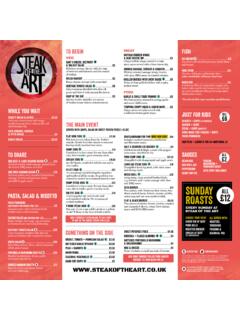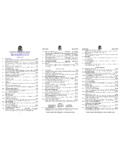Transcription of Tables on weight yield of food and retention …
1 BFE - R - - 02 - 03 Tables on weight yield of food and retention factors of food constituents for the calculation of nutrient composition of cooked foods (dishes) Berichte der Bundesforschungsanstalt f r Ern hrung ISSN 0933 - 5463 Berichte der Bundesforschungsanstalt f r Ern hrung BFE - R - - 02 - 03 Bundesforschungsanstalt f r Ern hrung Karlsruhe 2002 Antal Bogn r Tables on weight yield of food and retention factors of food constituents for the calculation of nutrient composition of cooked foods (dishes) Table of Contents Preface Part 1 : weight yield by cooking of foods and dishes I Determination II Tables on weight yield factors by cooking of foods and dishes milk and milk product based dishes (table 1) egg based dishes (table 2) meat based dishes - veal (table 3) - beef (table 4 / 5) - pork (table 6) - beef and pork mixture (table 7) - lamb, mutton (table 8) poultry based dishes (table 9) game based dishes (table 10) offal based dishes (table 11) meat products based dishes (table 12) salt and fresh water fish, crustacean and molluscs based dishes (table 13) soups (table 14) gravies and sauces (table 15) stews (table 16) vegetable based dishes - root ,tuber and stem vegetables (table 17) - leafy vegetables (table 18) - flower and fruit vegetables (table 19) - seed vegetables and legumes (table 20) - potato and potato products (table 21)
2 - mixed vegetables (table 22) vegetable based juices (table 23) mushrooms based dishes(table 24) fruit based dishes - fruits with core (table 25) - stone fruit (table 26) - berries, wild and exotic fruits (table 27) fruit based juices (table 28) cereal based dishes - grains and seeds (table 29) - flour and pastry (table 30) - bread, cake and rolls (table 31) coffee and tea based beverages (table 32) Glossary of the food and dish names ( English /German) Part 2 : Average retention of food constituents (nutrients) by cooking of foods and dishes I Determination II Tables on average retention factors of food constituents by cooking of foods and dishes milk and milk product based dishes (table 1) egg based dishes (table 2) meat based dishes - veal and beef (table 3,4) - veal and beef ,breaded (table 5) - pork (table 6) - pork ,breaded (table 7) - lamb, mutton ,game (table 8) - lamb, breaded (table 9) - mixed meat and meat product (table 10) - mixed meat and meat product ,breaded (table 11) poultry based dishes - chicken (table 12) - chicken , breaded (table 13) - duck , goose (table 14) - duck , goose ,breaded (table 15) - turkey (table 16) - turkey ,breaded (table 17) offal based dishes - liver, lung, kidney ,tongue (table 18) - liver, breaded (table 19) fish based dishes - low fat fish (table 20)
3 - low fat fish ,breaded (table 21) - fat fish (table 22) - fat fish ,breaded (table 23) crustacean and molluscs based dishes - crab mussel, squid (table 24) - crab mussel, squid (table 25) vegetable based dishes - root ,tuber and bulb vegetables (table 26) - root ,tuber and bulb vegetables , breaded (table 27) - stem, flower and fruit ,corn and seed, vegetables (table 28) - stem, flower and fruit ,corn and seed, vegetables ,breaded (table 29) - leafy vegetables (table 30) potato based dishes (table 31) potato products based dishes (table 32) mushrooms based dishes - chanterell, flat, oyster, mushroom (table 33) - mushroom, breaded (table 34) legume based dishes (table 35) fruit based dishes ,jelly ,jam (table 36) cereal based dishes (grains and seeds, table 37) cereal flour based dishes (pasta, bread , cake ,pizza ,table 38) coffee and tea based beverages (table 39) Glossary of the food constituents ( English /German) Appendix A - Examples for conversion of base recipe to100 g edible portion of ready - to - eat dish Appendix B -Examples for estimation of nutrient ,salt ,water and energy content of 100 g edible portion of ready - to - eat dish Appendix C -Description of cooking methods -Glossary of the names of cooking methods ( English /German) Reference Tables on weight yield and nutrient retention factors for the calculation of nutrient composition of cooked foods (dishes) (14th October 2002) Dr.
4 Antal Bogn r, Dir. and Prof. Federal Research Centre for Nutrition, Institute of Chemistry and Biology, Haid- und-Neu-Str. 9D 76131 Karlsruhe, Germany Preface To assess and improve the nutritional status of the population, data about the energy and nutrient content of composite foods are necessary because a large proportion of the food consumed is cooked or prepared. As the majority of nutrient databases provide information mainly on the nutrient composition of raw foods, continued efforts have been made by several countries all over the world to update and harmonise the food composition databases and to include the nutrient composition of cooked and prepared foods [3]. The chemical analysis of cooked foods (dishes) involves high costs in terms of time and money and cannot be applied in practical situations epidemiological studies, institutional kitchens, private households.
5 As it is virtually impossible to analyse every dish item and other prepared foods, calculation of the nutrient composition is still the method of choice. Experimental results have shown that between the analytical and calculated content of nutrients in prepared foods maximum correspondence is achieved when calculations are based on the following data [1, 2, 3]: a) Data of nutrient content per 100 g edible portion of raw ingredients [4]. b) Quantity of ingredients for preparation of 100 g edible portion of cooked food (dish) in the ready-to-serve condition. c) retention factors of food constituents during cooking. Cookbook recipes usually fail to provide information about the quantities of food obtained after preparation. Therefore weight have to be measured or borrowed from the pertinent literature. In part 1 of this study the algorithm used for determination of weight yield are described and Tables of weight yield factors due to different cooking methods for about 700 foods and dishes are presented.
6 The weight yield factors in the Tables are based on data in the pertinent literature and on analytical results from our own studies [5-8, 10-11]. They can be used to help estimate weight yield after cooking similar foods and dishes. In part 2 of this paper the formulae used for calculation and the Tables of average retention factors of food constituents after cooking of about 39 typical food (dish) categories are contained. The actual retention factors for protein, fat, carbohydrates, vitamins, minerals, cooking salt, sodium, potassium, magnesium, calcium, phosphorus and iron are statistically approved values. For some other food constituents, in particular niacin, biotin, folate, pantothenic acid, vitamin E , K and B12, fatty acids, amino acids, cholesterol the retention data available are incomplete and should be regarded as estimated retention values.
7 For any other food constituents, for which at present no data are available, using a retention factor of is preliminarily recommended. Using fat as cooking medium in frying pan or deep fryers for cooking of breaded meat , fish filet etc., fat uptake in gram per 100 g initial food ingredient is also indicated. factors for cooking salt absorption during boiling and steaming of foodstuffs are also given in the Tables . The average retention factors in the Tables are calculated on the basis of on data in the current literature [5-9] and on analytical results from unpublished studies [11]. Since cooking procedures of foods , as far as temperature and time are concerned, are more or less similar in all European countries, the presented retention factors may be used as basic data to calculate the nutrient composition of dishes. This would also considerably improve the compatibility of the different nutrient databases for cooked foods and dishes.
8 It is also of great importance that the data set for nutrient retention factors be further developed and extended to other countries. In industrial food processing cooking conditions are frequently different from household and large kitchen cooking. food manufacturers should therefore determine retention factors of food constituents for each product by analysis and using the algorithm described in paragraph 2. Examples and algorithms for converting a base recipe to a 100 g edible portion dish in ready-to-serve condition and for calculation of the nutrient content per 100 g dish are described and illustrated in appendix A and B. Information about the cooking methods used are contained in appendix C. With the publication of the present work my special thanks go to S. Dieterich (Federal Research Centre for Nutrition in Karlsruhe) for helping to create and correct the Tables , to L.
9 Bergstr m (Uppsala) and Dr. I. Martins ( Lisbon) for valuable contributions and providing data, to Prof. Dr. B. Tauscher ( Head of Federal Research Centre Karlsruhe) for support and Dr. E. Kirchhoff ( Deutsche Forschungsantalt f r Lebensmittelchemie, Garching) for reviewing the text and Tables . Dir. and Professor Antal Bognar Part 1: weight yield by cooking of food and dish I. Determination The preparation of food by heat processing in particular by cooking may lead to essential changes in weight and nutrient content. The extent of changes depend on many factors as the kind of ingredients, cooking method, equipment, temperature and time. Main effect of dish preparation by cooking on weight yield can be shared in the following groups: - preparation connected with an increase of the water content of a product for example, boiling, stewing of rice or legume.
10 - preparation connected with a reduction of the water content of a product for example, frying of meat, baking of bread . - preparation connected with a fat uptake and reduction of the water content of a product for example, deep frying of potato. Dry food as rice, pasta, legumes need a certain amount of water to obtain the common ready-to-eat condition. Additional water is needed to compensate the evaporation loss during cooking. Experimental data have shown that the water uptake by these foods is a linearly function of the food quantity, while the evaporation loss depends on other, non-predictable factors as the cooking equipment, the kind and size of the cooking pots, temperature and time [5-7,10]. Gravy, soup and pot-au-feu, for example, are supposed to show a certain consistence after cooking which is achieved by supplementing the water lost by evaporation, or by the evaporation of excess water.















